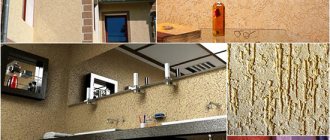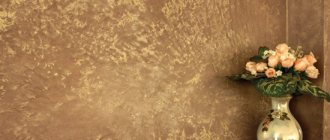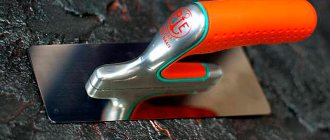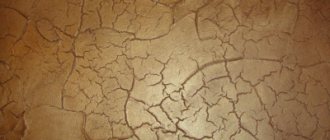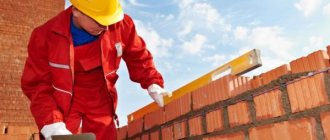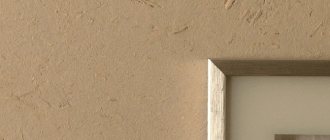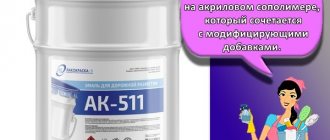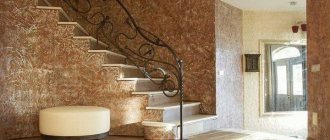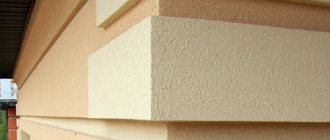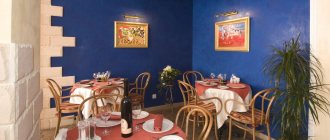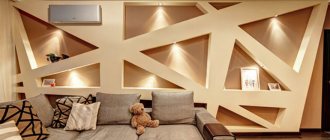Acrylic plaster is an ideal choice for those who want to save on finishing and insulating the facade. These mixtures are made on the basis of acrylic resins, which allows you to obtain a strong and durable coating. The warranty period declared by the manufacturers is at least 15 years. But to achieve such indicators, it is necessary to correctly select and apply the finishing composition.
Acrylic plaster
Acrylic plaster facade
Composition of acrylic plaster
Acrylic plaster is a finishing material based on synthetic resins.
The composition includes the following substances:
- Acrylic resins , giving the finished surface elasticity and beautiful appearance;
- Modifiers that significantly increase technical characteristics;
- Dyes;
- Filler that gives a different texture to the wall.
This type of plaster goes on sale in finished form. The color palette is very diverse, it will not be difficult to choose the desired shade. Since dyes are added during manufacturing in strictly certain proportions, they do not affect the characteristics of the composition. Antiseptic additives may also be present. Thanks to them, the plaster becomes resistant to various fungi and mold.
Silicate (silicate-silicone)
This type of plaster material contains liquid potassium glass (silicate). According to its characteristics, it is a compromise between acrylic and silicone plaster. It is also not susceptible to mold, vapor permeable, and moisture resistant. The price is between the two previous types.
The disadvantage of silicate mixtures is that they have the smallest choice of colors among polymer decorative coatings; only pastel colors are available.
Among experts who have worked with silicate plasters, there is an opinion that this material itself is simply a marketing ploy by manufacturers; plaster is more expensive than acrylic plaster, but in terms of performance characteristics it cannot be compared with silicone decorative coatings.
Examples: Ceresit CT 174 Pebble.
Characteristics of acrylic plaster
This type of finishing material has a large number of positive aspects. The strength and elasticity of the material is complemented by the following characteristics:
- Frost resistance and water-repellent qualities allow it to easily withstand any climatic conditions;
- Good air permeability allows the walls to “breathe”;
- The long service life allows you to maintain the appearance of the wall for up to 25 years;
- Combines perfectly with any mineral materials;
- A large color palette and the addition of dye during production ensure long-term color retention without changing the properties of the plaster;
- Easy application of the mixture allows for independent work without additional costs for paying specialists;
- Dries quickly, which reduces time wasting;
- Low price of acrylic plaster compared to silicone or silicate mixtures.
In addition, it repels dust and is easy to clean, making it suitable for use in highly contaminated environments, for example, when finishing industrial buildings.
Like any material, such plaster has its drawbacks. The main disadvantage is the flammability of such material. For this reason, caution is required when working with fire near an acrylic-treated wall.
Due to the large difference in operating conditions, a universal solution cannot exist. However, a large selection will help you find a solution for any case:
- Constantly high air humidity;
- Large temperature fluctuations throughout the day or year;
- Heavy dustiness in the air;
- Prolonged exposure to high ambient temperatures.
In addition, acrylic plaster is available in two types - for repair work and for decorative finishing of premises. Moreover, it can be for external work or for interior decoration.
The air temperature for working with such material must be at least 5 degrees. The time until complete drying is no more than 24 hours at an air temperature of 20 degrees. Depending on the additive fraction, the mixture consumption ranges from 1 to 4 kg/m2. It is worth paying attention that the larger the grain fraction, the higher the plaster consumption.
Review of manufacturers
Acrylic decorative plaster is presented in a wide variety on the market. You can select formulations from different price categories that differ in their characteristics, but the basic parameters remain the same. So, the most common are:
- The German company Henkel, which produces the most famous brand called Ceresit. The material has a unique “pebble” texture. Ceresit brand bark beetle plaster is often used by professionals for exterior finishing work. With its help, it is possible to create an original and interesting facade design, since the color range of mixtures is quite wide.
- French produces products in accordance with European standards. When using these mixtures, you can get a textured or structural surface, and painting on plaster is quite simple and will allow you to achieve the ideal shade.
- The Austrian manufacturer Baumit offers compounds with high quality characteristics. Plasters are resistant to atmospheric, mechanical and biological influences. The surface retains its original appearance for a long time.
- The German brand Farbe is the embodiment of the best German technologies. Constant research in the field of manufacturing building materials allows us to improve the production process and produce plasters that have high strength characteristics and are absolutely safe for human health.
- Domestic “Osnovit” has all the necessary quality certificates. Excellent material parameters have been confirmed in accredited laboratories. Thanks to the presence of its own production facilities, the company produces products at an affordable price.
- Polsky produces new generation plasters. Thanks to the use of special polymers, the manufacturer was able to create a truly high-quality material that meets all approved requirements. Often used in the decoration of public buildings, such as hospitals, educational institutions, etc.
Each of the listed brands produces products that meet international standards.
Acrylic-based mixtures of these brands are highly resistant to external influences and have excellent visual qualities. To improve the reliability and durability of coatings, manufacturers offer related products, additional coatings and primer compositions.
Advantages and disadvantages
This material, like any other construction material, has positive and negative properties. When treating walls, you need to take into account the disadvantages of acrylic plaster.
The film hardened on the surface makes it difficult for moisture vapor to pass through: the walls are clogged. Therefore, it is better not to use it when decorating a facade insulated from the outside with dense mineral wool. In direct sunlight it fades and fades. Therefore, you need to choose rich, bright colors for the facade.
Intensively attracts dust and small debris. The surface is constantly dirty and needs to be washed frequently.
Despite such flaws, acrylic plaster is popular. This is because she has even more advantages.
- Minimal abrasion. Does not crumble, does not form stains when rubbed. If applied in compliance with the technology, it can last for decades.
- Reliable protection of the treated surface from moisture: snow, rain, hail.
- Strength. Significantly more than any other plaster. Acrylic film is very difficult to damage accidentally, unless intentionally and with a special tool.
- Elasticity - a high-molecular polymer, such as acrylic resin, prevents the formation of cracks due to external influences. Acrylic elastic plaster does not respond to shrinkage, fluctuations, sudden changes in temperature or humidity.
- Absolutely non-flammable. The walls do not require special impregnation to prevent fire. Acrylic facade plaster is ideal for surfaces insulated with flammable foam.
- Heat and sound insulation.
- Easy to clean: dirt can be removed with water.
- The mixture is ready to use.
The physical and technological properties of acrylic-based plaster have made it accessible even to a non-specialist.
Kinds
The name “acrylic plaster” implies a significant segment of materials. They are used for finishing interiors and for facades using plaster applied as a base. They have different purposes and properties that must be taken into account when choosing. Based on the type of surface, textured, structural, mosaic and Venetian plaster are distinguished.
The classification of acrylic plaster for external or internal use is arbitrary, since all types, with the exception of Venetian, are suitable for both types of work.
Textured
Fillers include fine stones, mica, and flax fibers. They create a coating that resembles wood, stone, or leather. The relief appears immediately upon application.
Acrylic textured plaster comes in the following types:
- “Bark beetle” is a combined composition with stone filler of small fractions. Bark beetle plaster consists of decorative cavities, similar to natural ones, made by a beetle. It looks interesting, but in combination with the zero antistatic properties of acrylic it leads to increased contamination of the surface. From the street it can be easily washed with a hose, and inside the room it can be treated with a vacuum cleaner. Silicone plaster also has the same type.
- “Shuba” (popular name, also known as acrylic pebble plaster). The structure resembles a low pile. “Shuba” plaster is less contaminated because it uses a larger filler and the recesses are small.
- “Lamb” is an imitation of sheep’s fleece. Pebbles added to the composition create a surface with uniform grain and roughness.
Textured is the best acrylic plaster for the facade. And its low cost makes it the most popular among other decorative ones.
Structural
The future surface relief is determined by the composition of the filler. The mineral base consists of fine quartz or marble chips, creating beautiful heterogeneity and granularity. If they are very small, then the wall will be almost flat; the middle fractions will give the finished surface a more significant relief.
Adheses well to chipboard, drywall, and other mineral structures.
Mosaic
It is a thin-layer composition filled with quartz or marble chips with a grain size of one and a half to two millimeters. Colored granules (mosaic) make the use of synthetic dyes unnecessary. Shiny tiny fragments create an iridescent effect. Acrylic mosaic plaster is applied to plasterboard, cement-sand, cement-lime layer, putty, chipboard.
Venetian
Outwardly, it resembles real marble, and when processed with coloring pigments, it resembles precious stones. Different application methods create a shiny or matte surface. Application allows you to visually increase the space, so the material is ideal for small spaces. Acrylic Venetian plaster is the only acrylic plaster used only for interior work. Silicone plaster of this texture does not have such restrictions.
The mentioned varieties differ, in turn, in the size of the filler, colors, patterns, and are used in different interiors. For example, mosaic acrylic plaster for interior work is appropriate for solid public spaces. Venetian texture is more suitable for living rooms. Walls with this coating are smooth, shiny, almost mirror-like. They will always cheer up the owners and surprise the guests.
For outdoor use
Acrylic plaster for exterior use is notable for the fact that it has better characteristics, since operating conditions are much worse. External use involves the creation of a decorative layer. All compositions for facades can be divided into 3 types, depending on the finished result:
- "Bark beetle." Thanks to the filler, after application and grouting, a textured layer is formed on the surface, reminiscent of wood, on which the bark beetle has worked. Caverns (depressions) are formed on the surface in a chaotic manner. Moreover, their direction depends on the movements of the trowel during grouting. A fairly popular finishing option that allows you to paint in two layers. Looks beautiful. However, the downside is the difficulty of care. The furrows can become dirty and not easy to clean. A famous representative of the “Bark Beetle” is the acrylic plaster Ceresit ST 63 and ST 64.
- "Fur coat". A well-known option from the past that does not lose relevance. Instead of depressions and grooves, as in the first case, a relief texture with tubercles is created on the surface. In some ways it resembles fine-grained pebbles. Therefore, acrylic plaster received another name as “pebble”. Among specific manufacturers, we can note Ceresit ST 60, Siltek Decor Pro Pebble.
- "Mosaic". The main difference between plaster is that it does not contain dyes. Color and texture are created by crumbling colored stones. It also contains quartz sand and mica. All these components are held together with acrylic resins. Fibers and similar decorative components are often added to mosaic mixtures. A representative of mosaic acrylic plaster is Ceresit ST 77.
For internal use
Finishing the internal perimeter is much easier, and the operating conditions are much gentler. Therefore, the requirements for such mixtures are not so high. Compositions for interior work can be divided into three main types:
- Venetian. The peculiarity of this plaster is that it is applied in the thinnest layer. The result is a very smooth glossy surface. The appearance is beautiful: imitation of expensive marble, as well as granite and basalt surfaces. The walls will breathe, they are easy to clean, acrylic Venetian plaster can be tinted and is odorless. It is easy to care for the decorative surface, since no depressions or grooves are formed on the wall. Representatives of the mixtures: ARTE VENEZIANO ELEMENT DECOR, Feidal Venedigputz.
- Structural. After application, a certain structure is formed on the surface. This is achieved through fillers in the composition: marble chips, quartz chips. The principle of operation is to apply the solution to a previously prepared surface. A regular trowel is used. Average composition consumption rates are up to 3 kg/m2.
- Textured. After application, a relief is formed on the wall. This is achieved not by the presence of fillers in the composition, but through skillful use of tools. To obtain a decorative layer, stamps, smoothers, rubber textured rollers, a brush and everything that is at hand are used. Here the finished result can be limited by the imagination of the master.
It is noteworthy that there are other types of mixtures that differ in fine details and finished result. For example, the options available on the market are “Wet Silk”, “Soft Velvet”, “Graffito”, “Sea Breeze”, etc. Elastic plaster Acrylit 415 is also on sale. This is a universal option used for both exterior and for interior decoration. There are coarse-grained (fraction up to 1 mm), medium-grained (fraction up to 0.5 mm) and fine-grained (fraction up to 0.15 mm).
Important ! Before using any type of acrylic-based plaster, it is better to read the instructions from the manufacturer. Each of them has its own characteristics. You can also find out on the packaging the consumption of acrylic paint per 1 m2 of plaster.
Video description
This video shows how decorative plaster is applied by spraying:
Handmade
Elastic plaster for facades and interior decoration is manually applied in an even layer using an easy-to-use tool with a metal blade. These can be spatulas, trowels, graters. The thickness is determined by the grain size of the mineral filler. The value should not exceed the maximum fraction by more than 2 times. The break between approaches can be up to 10 minutes. If this time is exceeded, transitions will be noticeable. It is important to stir the mixture periodically to prevent sediment from forming.
Method of manual application of decorative solution Source portseafood.ru
It is worth noting the fact that it is impossible to work with flexible plaster without contaminating the floor. During the application and distribution of the mass and grout, the mineral filler partially crumbles. The final smoothing of the surface is carried out simultaneously with moistening the coating by spraying water. Therefore, it is important to protect floors from both plaster and dampness.
Strengthening the protective properties of acrylic plaster
Acrylic plaster can be given additional properties that will help protect walls from moisture and insects. For this purpose, various antiseptics and water repellents are used.
If the façade is made of concrete, you can use Kartotsid-compound.
Construction antiseptic
This antiseptic is an effective means of protection against biological damage. It can be added to dry and wet building mixtures. “Kartotsid-compound” is made on a water basis, so there are no obstacles to its use with acrylic plaster. To impart protective properties to the mixture, it is enough to add 5% of the antiseptic to it based on the total volume of the finishing composition. After which the plaster is mixed with a drill equipped with a metal mixer.
It is best to mix the solution with a drill or construction mixer.
Acrylic plaster application technology
Each type of plaster mixture has some specific differences when applied to the surface. But still, the surface should be covered with acrylic plaster, taking into account the following stages of the work process:
- We prepare the surface. The walls should be leveled as much as possible, since the acrylic composition is applied in a thin layer and the coating will not hide strong unevenness.
- We prime the plane. When applying the primer layer, dust and dirt are removed, micropores and cracks are sealed. Therefore, the putty composition will adhere tightly to the wall surface.
- We apply plaster. Depending on the type of mixture (it can be thin- or thick-layer), we use the necessary tools.
Thin layers are laid by hand. Here you may need a trowel, spatula, sprayer or roller. This decorative plaster composition has unsurpassed plasticity and can be easily applied even by a beginner. It is more convenient to apply thick layers of solution using a special machine. Here it is best to use dry mixtures, which are diluted with water to the required consistency. In any case, before starting work, carefully read the instructions on the packaging for applying the type of plaster you are using.
It is recommended that the surface finished externally with plaster mortar be additionally coated with a special acrylic facade plaster paint for exterior use. This will extend the life of the decorative coating. For clarity, I advise you to watch a video in which the master will talk about the rules for applying acrylic composition to the internal and external surfaces of the building. I also recommend a selection of photos of interesting design ideas for facades made with acrylic plasters.
Surface preparation
To ensure that the plaster coating is durable, does not peel off, sticks to the wall, does not bulge, does not fall through, does not turn red, and does not become covered with stains of leaked salts, the base is prepared before applying it:
- Oil stains and efflorescence are removed, fungal and mold areas are cleaned and disinfected;
- remove old paint and wallpaper;
- remove excess metal objects (nails, screws), insulate the remaining ones;
- tap the old plaster finish, remove peeling areas, knock down protrusions, repair cracks and potholes;
- uneven walls are leveled with putty or cement plaster;
- in brick walls, use a chisel to deepen the seams a centimeter;
- remove dust;
- wooden coverings are covered with fiberglass mesh;
- apply a primer to the base, then leveling putty;
- dried.
As a result, the wall should be clean, smooth, slightly rough, and dry.
wall preparation
Under acrylic plaster, applying a primer is a necessity, since when water is drawn out of the solution by the base material, the ability of the plaster composition to properly harden is lost. The coating will be defective. To prevent this from happening, the pores of the walls must be reliably plugged with a primer.
Painting applied acrylic plaster
A large color palette and durable elastic surface eliminate the need for mandatory painting of the plastered wall. However, a design decision may require painting the entire wall or sections of it. Non-waterproof water-based paint will look advantageous on embossed textured plaster. After complete drying, treat the painted surface with a damp sponge. The paint will be washed off a little from the protruding elements, its tone will be much lighter than in the recesses, which will give more volume to the texture. This painting method is suitable exclusively for interior work. For the design of the facade, if necessary, paint for external work, lek, wax and other similar materials are used.
Painting plaster composition
Any aqueous compositions become less saturated in color after drying. This should be taken into account not only in relation to water-based paint. Acrylic plaster also becomes less saturated in color. Based on this, more color is added to this type of finishing material. The easiest way to obtain the required shade are programs that calculate the required amount of tinting paste for a certain volume of plaster. Such calculations will allow you to obtain the same shade for the entire wall area. Similar programs are installed in almost all large stores.
Silicone
The protective and decorative properties of the coating are especially important for the facade and basement of the house
This finishing material contains an additive in the form of silicone resin to improve the properties:
- Silicone plaster is already devoid of such a disadvantage as high adhesion of dirt to the wall.
- Colors last better due to increased UV resistance.
- Vapor permeability also increases. The remaining advantages remain the same as in the previous version.
For facade work, silicone plaster is the best choice in terms of quality. But the price is 20-30% more expensive than acrylic.
Examples: Ceresit CT 74, Perel Silicio Bark Beetle, ECOROOM SILKSTONE.
The video below shows a comparison of two types of façade polymer plaster.
Care of acrylic plaster
The finished acrylic coating is easy to maintain. Inside the room, it is enough to wipe such surfaces as needed with a damp cloth soaked in a soap solution. The outside coating is more susceptible to contamination. Therefore, cleaning here is carried out using a directed stream of water. You can use a regular garden hose with a special nozzle, which sets the direction of the water stream and thereby increases the pressure. Thanks to such cleaning, the coating is quickly cleaned and again pleases you with its attractive appearance.
Choice of coverage
When choosing, what matters is the area where the floor covering will be applied, the conditions, the timing of the work - for example, methyl methacrylate solutions have a very short hardening period, so they can be put into operation in just two days, polyurethane solutions can withstand high dynamic loads well, and the peculiarity of cement-acrylic self-leveling floors – their ability to effectively level even the most difficult areas. It is the latter option that is most suitable for residential premises due to its safety and aesthetic appearance.
The self-leveling floor can level even the most difficult areas
Advice from the experts
Experienced builders know how to avoid mistakes when working with acrylic elastic plaster. They advise:
- Do not start work when tired. It is better to wait until the person is healthy and well rested.
- It is better to start the process in the morning to do everything at once. This way you can avoid differences between the walls and achieve a uniform decorative layer.
- Do not forget about personal protective equipment to prevent the solution from getting into your eyes.
- It is better to apply it from a corner, distributing the acrylic composition over the wall.
- Drying should occur under natural conditions. There is no need to speed it up by using hair dryers, heaters or similar devices. This is fraught with the formation of cracks and destruction of the created layer.
- The optimal thickness of the acrylic layer is 2-3 mm. There is no need to make it thicker.
- The process is performed at temperatures from +5 to +25 degrees, wind and draft are not allowed. Humidity no more than 60%.
Acrylic plaster is a universal option that can be used to decorate a room inside and outside. Thanks to it, a unique appearance, Venetian gloss and modern design are created. And thanks to its characteristics, it will last for decades.
Possible mistakes
Proper installation requires careful attention to all work carried out. Certain points to take into account:
- too high humidity of the base surface;
- increased content of dust and dirt;
- poorly carried out degreasing of the surface;
- fragility of the base surface, presence of cracks;
- poorly mixed filling solution;
- non-compliance with technology, violation of the sequence and timing of laying layers.
Poor preparation of the base and violation of installation technology can lead to cracking of the self-leveling floor.
To avoid problems in the future, it is worth carrying out the work correctly
Making your own mixtures
Almost any textured plaster can be made independently. The only exception is mosaic mixtures.
Production of textured compositions such as bark beetle and lamb beetle
In principle, you can take a ready-made composition, dry or in the form of a mixture, as a basis. It can be cement, cement-lime, silicate, acrylic, gypsum or gypsum-lime plaster. The choice is made based on your needs: for facade or interior work, for dry or wet rooms, etc.
There is no specific recipe here. Just take a package of the finished mixture and dilute it according to the instructions. Next we introduce the filler – stone chips. The amount of the latter will have to be determined experimentally. We start with 1 kg per 10 kg bucket. We try to apply it on some flat surface, if we see that the texture turns out to be inexpressive, we add more. If the textured decorative plaster ends up being too thick, thin it out a little.
Textured plaster for walls: the photo shows an example of finishing with the optimal amount of filler
And now regarding the nature of the filler. The type of stone is not important here; the grain fraction is more important. The bark beetle contains crumbs with a diameter of 1.5 to 3.5 mm. For interior decoration, it is better to take a grain of up to 2 mm; larger grains are suitable for facades. The lambs contain a mixture of stones of different fractions, from 1.5 to 3 mm. How to apply textured plaster - you can watch the video in the next section.
Please note: mosaic textured plaster cannot be created at home. This is due to the characteristics of acrylic resins used in such compositions as a binder
In the wide market you can only find acrylic for creating artificial stone, but this is not suitable for us.
Relief plaster on walls: photo of “lamb” coating
Textured mixtures based on putties
Textured plaster made from ordinary putty successfully imitates expensive Venetian mixtures and “marbled” ones. The basis of the composition can be any, at your discretion. We choose it according to the same principle as described above for the bark beetle and lamb. As a filler we use sifted white sand in the proportion of 1 kg of sand per 10 kg of putty. Tinting is done “by eye”; you just need to check with the seller whether it becomes lighter or darker when it dries.
Textured plaster in the kitchen: finishing based on putty
The type of texture that can be obtained using such a composition depends on the application technique - we will talk about it below. Textured plaster made from ordinary putty requires a finishing coating - it provides the missing visual effect. The recipe is as follows:
- Wax for decorative plaster – 1 part.
- Water or other suitable liquid, depending on the type of wax - 10% by weight of the latter.
- Metallic or pearlescent color – 30% of the wax weight.
Roughly speaking, if we take 1 kilogram of wax, then we will need 100 g of water, and 300 g of color.
What does the cost depend on?
The issue of price is one of the main ones in construction and repair work. The materials used for laying self-leveling mixtures are not cheap, but significant savings are provided by the conditions for carrying out the work - the ability to do it yourself, and the speed of drying the layer. The cost of such a floor largely depends on the chosen composition and layer thickness - a properly carried out preparatory stage will also help save money. The price is necessarily increased by special properties - for example, greater transparency, unusual coloring, antistatic or anti-slip effect.
The issue of price is one of the main ones in construction and repair work.
